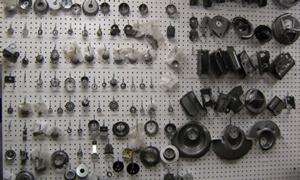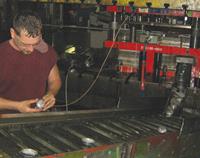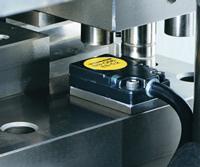Contributing editor
- FMA
- The Fabricator
- FABTECH
- Canadian Metalworking
Categories
- Additive Manufacturing
- Aluminum Welding
- Arc Welding
- Assembly and Joining
- Automation and Robotics
- Bending and Forming
- Consumables
- Cutting and Weld Prep
- Electric Vehicles
- En Español
- Finishing
- Hydroforming
- Laser Cutting
- Laser Welding
- Machining
- Manufacturing Software
- Materials Handling
- Metals/Materials
- Oxyfuel Cutting
- Plasma Cutting
- Power Tools
- Punching and Other Holemaking
- Roll Forming
- Safety
- Sawing
- Shearing
- Shop Management
- Testing and Measuring
- Tube and Pipe Fabrication
- Tube and Pipe Production
- Waterjet Cutting
Industry Directory
Webcasts
Podcasts
FAB 40
Advertise
Subscribe
Account Login
Search
Sensors clear the way for high-speed stamping
Safely navigating the press autobahn
- By Kate Bachman
- April 15, 2008
- Article
- Bending and Forming

Tennessee Stampings (Portland) LLC stamps 100 million ride control components (struts and shocks) annually. To sustain high-speed stamping, the company puts sensors on all of its dies to prevent collisions and the production of defective parts that would bring its presses to a screeching halt.Photo courtesy of Tennessee Stampings (Portland) LLC, Portland, Tenn.
When you stamp 100 million automotive parts annually, as does Tennessee Stampings LLC, Portland, Tenn., you might accept die collisions as just part of the"traffic statistics."
Not if you want to achieve high speeds, according to Greg Cornett, plant manager of the Tier 2 supplier of ride control components (struts and shocks). Before the dies ever hit the high-speed presses, they are properly sensored, because no matter how fast a high-speed press can run, crashes and producing defective parts would bring it to a screeching halt.
"What we've probably done better than most companies is we've realized the importance of mistakeproofing our dies to avoid crashes," Cornett said.
Cornett credits much of the company's growth—approximately 23 percent per year for three years—to its emphasis on reducing die crashes.
"The main reasons our growth has been so great are mistakeproofing and in-die sensor systems," Cornett said.
Mistakeproofing Halts Crashes, Accelerates Pace
The company formed a mistakeproofing lab about four years ago to eliminate or at least reduce the downtime associated with troubleshooting after a die crash, part jam, or defective part production, to speed overall production throughput, Cornett said. The effort has diminished the hard costs of die crashes as well.
Bill Graves, the lab's manager, said that before the special mistakeproofing effort was made, dies crashed twice a week."If you crash a die, you can do easily $10,000 to $15,000 [worth of] damage in one stroke. Now, with the proper sensors, it might be six months before we have a die crash. In fact, we haven't had a major die crash since November of '05."
Occasionally crashes do occur during setup, because the sensors are not enabled during setup mode, Cornett said."Attempting to set up a die with the sensors enabled creates excessive nuisance stops, so the sensors are bypassed in the setup mode. The operators must pay attention to every stroke to prevent the occasional mis-hit—that's where most of our crashes come from," he said.
"It is easy for a new hire to accidentally mislocate the strip in the die during setup. For this reason, we have an extensive in-house training program for all our new hires," Cornett said.
Before Entering the On-ramp
When Tennessee Stampings is given"takeover" work, often the dies arrive in poor condition and are not equipped with sensors."We won't run a die without specific sensors being installed first—even on a temporary basis," Cornett said.

Sensors are fitted into a 41-pin military connector that acts as an umbilical cord from the die to the press control so the sensors are ready to go at die setup. Photo courtesy of Tennessee Stampings (Portland) LLC, Portland, Tenn.
The company does not build its own dies, but its sensor department designs the sensor system for new tools based on tooling CAD and sends the design to the tool builder before the dies are built. In addition, the stamper has a fully capable toolroom that can retrofit the acquired dies with sensors. Sensors are sourced from Turck, Banner, and Balluff.
"The use of sensors in and on dies is becoming more important all the time, especially with many stamping companies going offshore for their dies and for production," said Brian Tarbox, business development manager, TURCK."It is especially important for domestic stamping companies competing globally. By using sensors in their dies to monitor critical functions during the stamping process, companies can reduce downtime, maintenance, and scrap, as well as improve productivity and quality."
Choosing the right sensor for the application is critical to the success of a sensor program and to achieve efficiency, Tarbox added.
"The right sensor can last for more than 2 million strokes if it's buffered well," Cornett said,"but it won't last a stroke if it's not protected right."
It is primarily the wires going to each sensor that need protection, Cornett said."When we first started our sensoring program, if you took a picture of the press, it would look like a rat's nest of wires." At first the wires were encased in square tube to protect them from getting cut—as a result of what Cornett calls the"gorilla effect.""If something can be damaged or broken, it will be."
Now, for most dies, channels are milled into the die to embed the wires."It's part of our die standards," Cornett said."If it's a high-volume die, we will mill out pockets and try to embed them for increased protection."
More recently the sensors are fitted into a 41-pin military connector that acts as the umbilical cord from the die to the press control."So every time we set up this die, it's ready to go. In the past it was like a jigsaw puzzle, trying to determine where sensor wires go, but now we just come in, plug up, and go," Cornett said.
Keeping All Four Wheels on the Ground
Cornett said that every die has a minimum of four sensors:
- To prevent misfeeds
- To prevent overfeeds
- To ensure parts exit
- To ensure slugs exit
"You're going to have a misfeed sensor, indicating that the material fed up to the right location each time; you're going to have an overfeed sensor to ensure that you didn't overfeed it; you've got the part-exit sensor, which makes sure a part exits that die every stroke, because if it stays in there, you're going to crash this die; and then we use what's called a stripper sensor," Cornett said. A stripper sensor monitors the distance between the upper stripper plate and the bottom die section at 180 degrees. If a slug stays in the die, which would damage parts, the stripper distance will change. The stripper sensor detects this change, stops the press, and alerts the operator, thereby preventing defective parts, Cornett said.
TSL's press tonnages are from 75 to 800. The stamper places a higher priority on sensing up dies for the larger presses first, but even small dies can be equipped with many sensors, such as a small deep-draw die for stamping small internal components on a press running from 150 to 250 strokes per minute (SPM)."A lot of dies have nitrogen gas in them," Cornett said."If gas cylinders leak and nitrogen pressure changes, that can affect part quality. So we monitor the pressure in our nitrogen cylinders. If the pressure exceeds or drops below a certain set limit, the sensor shuts off the press.

A rectangular-style sensor senses the distance needed to detect slugs in this die. Photo courtesy of TURCK Inc., Minneapolis.
"You can do the same sensoring on smaller dies as you do on the larger ones. We just have a different type of plug, since you don't have as much on some die shoes to mount 41-pin connectors."
How Sensors Work
As a part nears its final configuration, an inductive proximity sensor verifies that the guide pin is correctly engaging the pilot hole, thus ensuring correct punch hole positioning in the progressive die.
A typical sensor sends out a fishtail signal and measures what is inside that fishtail, Graves said."If you've got what we call an XYZ coordinate machine, you can set up a sensor and actually measure what you're getting inside that field.
"So you know when you're in that die, you need to be 2.5 millimeters from where you're measuring."
Graves said he uses LabVIEW software, also used by NASA, NASCAR®, and Xbox®, to track the signal.
"Every press stroke produces a signal, kind of like an EKG of a heart. If the punch is dull or broken, it takes longer to break through the material, so the line gets longer. Or if it's not there at all, you're going to flatline, it's going to give you a fault," Graves said.
"Before, if you're running 100 SPM, and you have a broken punch and it's been five minutes since you checked your parts, that's quite a few parts that you're going to be scrapping. But this type of technology detects the broken punch, shuts the press off, and alerts the operator," Graves explained.
"We try to apply all the technology that we can find and create so the dies get better parts, faster, and without having quality issues. We want to be able to track what we're doing," Graves said.
Resolver-based press controls are required to use sensors, Graves said."If you didn't have something telling you where you are in the stroke, your sensors wouldn't know where to cut off," he explained.
Keeping the Press Running
"When I ran a press, 15 to 18 years ago, I had to sit there and watch every stroke with my hand on the stop button, watching for that material to short-feed or for a part to not come off," Cornett said."You couldn't leave it running when you went on break. Now, with our sensor program, some operators will let the press run until the coil runs out. Or maybe the shift will end and we don't have an operator; if it's near the end of the coil, we just let it run and finish the coil out. Sensors have just added productivity.
"When I first came onboard here in 2000, tooling maintenance represented 9 percent of total sales dollars. Last year we got that down to 4 percent. So in dollar numbers, it's pretty substantial," Cornett said.
For every problem, there is a sensor
Dave Fletcher, industry specialist, Banner Engineering, explained which sensors are used to detech misfeeds, overfeeds, part exit, and slug exit:
- Generally, misfeed sensors are inductive proximity switches, when they are mounted close, or photoelectric sensors, when you have enough space to place the sensor farther from the strip. Also, laser sensors can be used to detect a small, vertical attribute on the strip.
- Overfeed sensors usually are the same type of sensors used in misfeed sensing, except that they are mounted to detect the strip feature or attribute if the strip is overfed. Opposing mode sensors are preferable in these applications because of their tolerance to oil and dirt. Also, photoelectric sensors can sense farther than proximity switches, and with most retrofit applications, photoelectrics deliver greater range and working options.
- Photoelectric sensors work great for part-exit sensing because part ejection is less predictable than other sensing applications, since the part will fall or be blown off or ejected. Some sensors also can be set up to detect the part and ignore backgrounds.
- Proximity switches are usually used as stripper sensors to detect the stripper plate to see if a slug has been pulled.
About the Author

Kate Bachman
815-381-1302
Kate Bachman is a contributing editor for The FABRICATOR editor. Bachman has more than 20 years of experience as a writer and editor in the manufacturing and other industries.
subscribe now

The Fabricator is North America's leading magazine for the metal forming and fabricating industry. The magazine delivers the news, technical articles, and case histories that enable fabricators to do their jobs more efficiently. The Fabricator has served the industry since 1970.
start your free subscription- Stay connected from anywhere

Easily access valuable industry resources now with full access to the digital edition of The Fabricator.

Easily access valuable industry resources now with full access to the digital edition of The Welder.

Easily access valuable industry resources now with full access to the digital edition of The Tube and Pipe Journal.
- Podcasting
- Podcast:
- The Fabricator Podcast
- Published:
- 04/16/2024
- Running Time:
- 63:29
In this episode of The Fabricator Podcast, Caleb Chamberlain, co-founder and CEO of OSH Cut, discusses his company’s...
- Trending Articles
AI, machine learning, and the future of metal fabrication

Employee ownership: The best way to ensure engagement

Steel industry reacts to Nucor’s new weekly published HRC price

Dynamic Metal blossoms with each passing year

Metal fabrication management: A guide for new supervisors

- Industry Events
16th Annual Safety Conference
- April 30 - May 1, 2024
- Elgin,
Pipe and Tube Conference
- May 21 - 22, 2024
- Omaha, NE
World-Class Roll Forming Workshop
- June 5 - 6, 2024
- Louisville, KY
Advanced Laser Application Workshop
- June 25 - 27, 2024
- Novi, MI


























